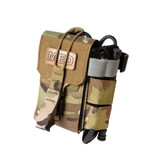Why Every Law Enforcement Officer Should Carry a Medical Kit
In high-risk professions like law enforcement, seconds can mean the difference between life and death. While most officers are equipped with firearms, body armor, and communication tools, one essential piece of gear is often overlooked: the medical kit. Whether responding to a shooting, car accident, or natural disaster, having a law enforcement medical kit on hand can save lives — including your own.
The Importance of a Medical Kit in Law Enforcement
Law enforcement officers are often the first to arrive at chaotic, high-stress scenes. Medical emergencies don’t wait for paramedics. Officers may face gunshot wounds, severe bleeding, blunt force trauma, or even cardiac arrest situations before EMS can arrive. That’s where a well-stocked and accessible IFAK (Individual First Aid Kit) becomes critical.
Life-Saving Intervention in the Field
The most common cause of preventable death on the battlefield — and in violent civilian settings — is uncontrolled bleeding. With tools like tourniquets, chest seals, and hemostatic gauze, officers can immediately treat themselves, a partner, or a civilian before help arrives.
Quick access to a medical kit can:
- Control major bleeding from the extremities
- Manage penetrating chest injuries
- Stabilize a victim with a gunshot or stab wound
These interventions buy crucial time until advanced medical personnel arrive.
Enhancing Officer Safety and Community Trust
Carrying a police trauma kit not only protects officers but also enhances community trust. Citizens want to know that the officers serving them are prepared for any emergency. The ability to deliver immediate first aid — especially in active shooter or accident scenes — can be a powerful demonstration of commitment to public safety.
Moreover, the presence of medical supplies and the training to use them can make a profound impact during routine patrols, traffic stops, or community events.
What Should Be in a Law Enforcement Medical Kit?
A well-equipped officer’s medical kit typically includes:
- Tourniquet (e.g., CAT or SOF-T)
- Chest seals
- Pressure bandages and medical tape
- Hemostatic gauze (e.g., Combat Gauze)
- Plain sterile gauze (to use in conjunction with hemo gauze for larger wounds or if cost is a factor)
- Gloves and shears
Additional items to consider:
- CPR face shield
- Emergency blanket
These items are compact, lightweight, and designed for rapid deployment in high-pressure scenarios.
Final Thoughts: Be Prepared, Save Lives
Law enforcement officers are protectors, responders, and often the first line of defense in medical crises. Carrying a medical kit isn’t just about gear — it’s about preparation, responsibility, and the will to act when lives are on the line.
If you're in law enforcement and not already carrying a trauma kit, now is the time to make it part of your EDC (Everyday Carry). Train with it. Know it. Keep an Eleven 10® med right there with you.
Explore Popular Articles
Why Every Law Enforcement Officer Should Carry a Medical Kit
In high-risk professions like law enforcement, seconds can mean the difference between life and deat...
The New Eleven 10® Responder MINI IFAK
Meet the New Eleven 10® Responder MINI IFAK: The Best IFAK for 2025 At Eleven 10® (E10), we design g...
Compressed Gauze vs. Hemostatic Gauze
The Efficacy of Compressed Gauze vs. Hemostatic Gauze in Controlling Uncontrolled Hemorrhage Unco...
Why Investing in a Quality Tourniquet Could Save Your Life
When it comes to emergency medical gear, there’s one tool that stands above the rest for saving live...

